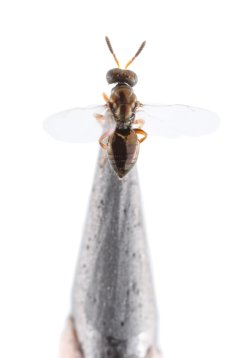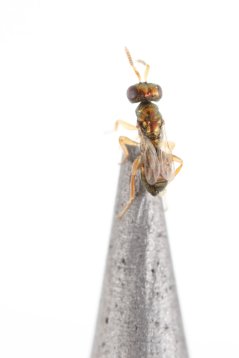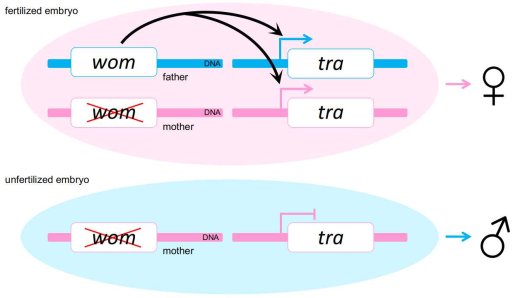Wageningen researchers discover why wasp fathers are only able to have daughters and not sons
It was already known that wasp fathers are only able to have daughters. Now biologists at Wageningen University & Research (WUR) and the University of Groningen (RUG) have discovered the cause of this: male wasps have an active gene in their sperm that is off in the DNA that the mother contributes to early wasp embryos. This finding is published today in the international scientific journal Science.
Wasps belong to the Hymenoptera order, a large group of insects including bees, wasps and ants. These hymenopteran insects have a special way of reproducing. During mating, the mother stores the male’s sperm. She then decides whether or not she wants to fertilise an egg. If an egg is fertilised by a sperm, a female wasp emerges that has two sets of chromosomes: one from the mother and one from the father.
If an egg is not fertilised, it will result in a male that has only the one set of chromosomes from its mother. Researchers already knew that the father’s DNA had to differ somehow from the mother’s (Verhulst et al. Science 2010). Now they also know exactly which gene causes fathers to produce only daughters and no sons. These results will be published today in the international journal Science.


Active father gene overrules ‘switched off’ female gene
The wasp in question is Nasonia vitripennis, a wasp measuring only 2 millimetres that parasitizes flies by laying its eggs in the fly (the pupae).
By sequencing all of the genes that are turned on in the very early embryos of the Nasonia, the researchers could determine which gene was switched on only in the embryos from fertilised eggs. In the genome (the complete genetic composition) of the wasp, they discovered a gene that is off in the DNA that the mother contributes to the egg which results in the eggs becoming male. But in the DNA from the father’s sperm cell, this gene is turned on.
So if an egg is fertilised, it has two sets of chromosomes: one with the gene that is off and one with the gene that is on. As a result, the eggs that also have a set of chromosomes from the father develop into females. The researchers have called this gene the wasp overruler of masculinization (wom) because when the gene is turned on it ‘overrules’ the development of a son.
Signal flags on DNA
Although the exact mechanism with which the mothers turn off their own gene is not yet clear, it is clear that so-called ‘genomic imprinting’ plays a role. Genomic imprinting is a phenomenon that causes genes to be turned on or off in a specific way. This does not alter the code of the DNA (the order of letters) itself, but the DNA is given small signal flags.
This is the first time that parent-of-origin depending genomic imprinting has been discovered to play a role in determining the sex of insects, and the researchers now want to determine exactly how this phenomenon works for this specific gene.

Useful for biological control
Because Nasonia wasps parasitise and thereby kill flies, they are a useful biological ally in combatting the problem of nuisance flies in cattle stables. For this reason they are a model species for all parasitic wasps used in biological control. Only females are useful in combatting pests because only they lay their eggs in pest insects. The percentage of female offspring depends on diverse factors, including the father’s wom gene. So understanding how sex is determined in parasitic wasps is useful for making biological control more efficient.

